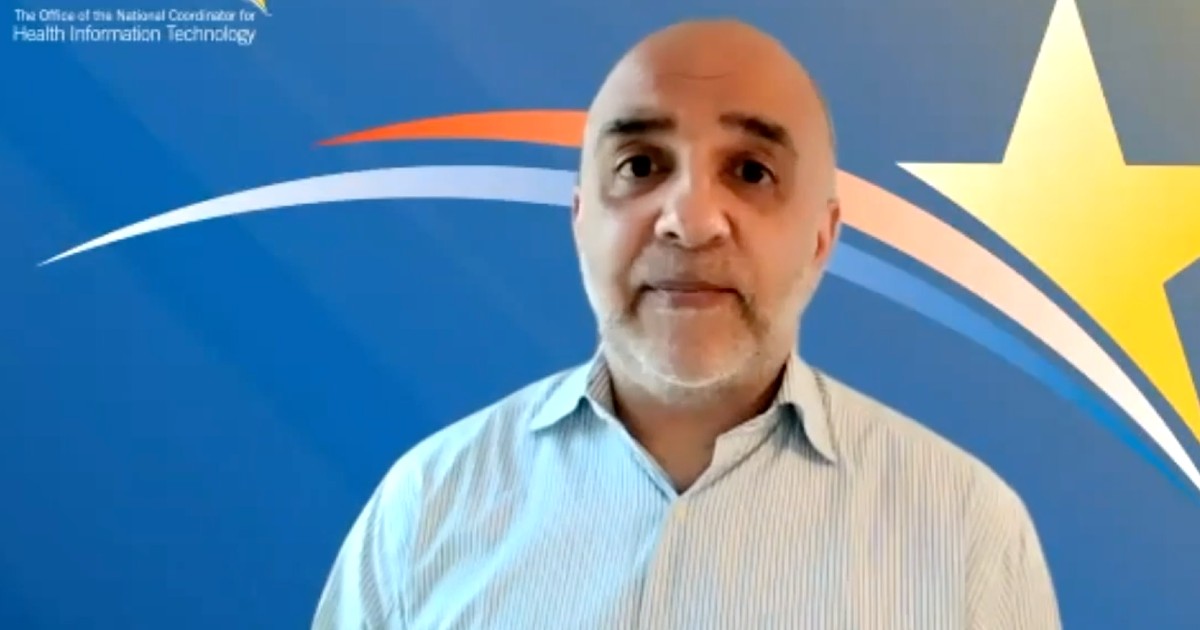Photo: HIMSS Media
National Coordinator for Health Information Technology Micky Tripathi says that 2022 will bring the policy and technical infrastructure necessary for nationwide information sharing – making it a transformative year.
“This year providers, patients, payers, public health practitioners, technology developers, researchers and other stakeholders will take the decade-long investment in health information technology to the next level,” wrote Tripathi in an article for Health Affairs published Tuesday.
WHY IT MATTERS
In the piece, Tripathi observes that key provisions of the 21st Century Cures Act will be implemented in 2022, acting as critical pushes toward clinical interoperability.
For instance, Tripathi pointed to continued implementation and enforcement of the information blocking regulations, which will prioritize practices that do not interfere with access, exchange and use of electronic health information.
“At the ONC, we don’t think about ‘information blocking’ so much as we think about ‘information sharing,'” Tripathi said.
The Cures Act and its attendant final rule include provisions that complement existing federal information-sharing policies – namely, HIPAA, Tripathi explained. They do so by covering a broader group of healthcare entities, directing information sharing with authorized entities and advancing information sharing to be more responsive to patient and clinician needs.
He noted that starting on October 6, all actors – providers, certified health IT developers and health information networks – will be expected to share all electronic health information, not just the data elements represented in the United States Core Data for Interoperability V1.
“In recognition of the fact that EHI beyond such data elements is typically non-standardized, heterogenous, and often not easily shareable, the rule allows some flexibility in how an actor can make EHI available in a variety of industry-standard formats and even, as a last resort, in a ‘machine-readable’ format,” he added.
Tripathi also cited forthcoming API standardization, which he says will make information sharing easier with certified electronic health record systems.
He pointed to April 1 and December 31 as deadlines requiring developers to ensure a level playing field for information sharing and enable access to information through application APIs “without special effort.”
“This will create a climate of innovation by allowing technology developers to build to a common, industrywide specification,” he said.
“Open APIs and apps are what make it easy to check your bank account or order meal delivery right from a mobile app regardless of which type of device you use. We want patients and providers to have that same flexibility and ease of use with medical records regardless of which technology platform they use,” he added.
Finally, Tripathi pointed to the interoperability promises heralded by the Trusted Exchange Framework and Common Agreement, or TEFCA, which launched in January of this year.
“The key goals for TEFCA are to: accelerate the tremendous progress already made by the market and establish a universal floor of nationwide interoperability based on uniform exchange contracts, open-industry technical standards, and transparent rules of the road; create the policy and technical infrastructure for organizations to securely exchange information to support patient care and generate health care value; and enable individuals to efficiently access their health care information from wherever it is,” said Tripathi.
THE LARGER TREND
Shortly after his appointment to lead the Office of the National Coordinator for Health IT earlier this year, Tripathi said the agency’s top goals included alignment, equity and, yes – interoperability.
“We’d like to use our collective federal muscle … to keep pushing forward toward an interoperability paradigm based on industry standards in the greatest way possible,” he said in March 2021.
Later that year at HIMSS21, Tripathi reiterated those goals, adding federal agency collaboration and alignment to the list – as well as continued COVID-19 response.
“The information sharing requirements of the Cures Act bring consistency across the industry by directing providers, vendors to health information networks to begin to make information sharing their default posture, which is a paradigm shift from HIPAA, which permits but doesn’t obligate such sharing of information,” he said.
ON THE RECORD
“The past decade was focused on laying a foundation for the use of EHRs. In 2022, the vision of the Cures Act will become a reality and allow us to start to reap the full potential of what a truly digital health care system can do to improve the lives of patients,” Tripathi wrote in Health Affairs.
Source: Read Full Article



